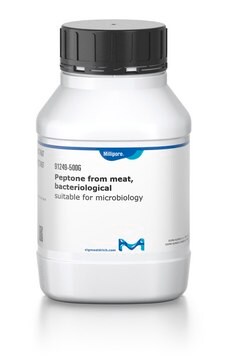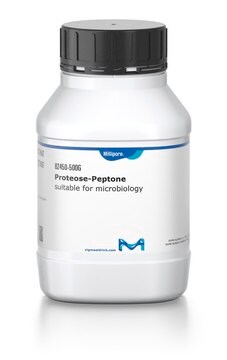81260
Poly(ethylene glycol)
average Mn 6,000, hydroxyl
Synonym(s):
Polyethylene glycol, PEG
Sign Into View Organizational & Contract Pricing
All Photos(2)
About This Item
Linear Formula:
H(OCH2CH2)nOH
CAS Number:
MDL number:
UNSPSC Code:
12352104
PubChem Substance ID:
NACRES:
NA.23
Recommended Products
product name
Poly(ethylene glycol), average Mn 6,000
form
flakes
Quality Level
mol wt
Mn 5,000-7,000
average Mn 6,000
pH
4.5-7.5
mp
60-63 °C
Ω-end
hydroxyl
α-end
hydroxyl
SMILES string
C(CO)O
InChI
1S/C2H6O2/c3-1-2-4/h3-4H,1-2H2
InChI key
LYCAIKOWRPUZTN-UHFFFAOYSA-N
Looking for similar products? Visit Product Comparison Guide
General description
Polyethylene glycol (PEG) is a hydrophilic polymer. It can be easily synthesized by the anionic ring opening polymerization of ethylene oxide, into a range molecular weights and variety of end groups. When crosslinked into networks PEG can have high water content, forming "hydrogels". Hydrogel formation can be initiated by either crosslinking PEG by ionizing radiation or by covalent crosslinking of PEG macromers with reactive chain ends. PEG is a suitable material for biological applications because it does not trigger an immune response.
Application
It has been used to modify therapeutic proteins and peptides to increase their solubility.
Photopolymerized PEG hydrogels have emerging applications in the fabrication of bioactive and immunoisolating barriers for encapsulation of cells.
Photopolymerized PEG hydrogels have emerging applications in the fabrication of bioactive and immunoisolating barriers for encapsulation of cells.
Related product
Product No.
Description
Pricing
Storage Class
11 - Combustible Solids
wgk_germany
WGK 1
flash_point_f
Not applicable
flash_point_c
Not applicable
ppe
Eyeshields, Gloves, type N95 (US)
Choose from one of the most recent versions:
Already Own This Product?
Find documentation for the products that you have recently purchased in the Document Library.
Customers Also Viewed
Joo-Hyung Choi et al.
Veterinary microbiology, 236, 108374-108374 (2019-09-11)
Foot-and-mouth disease (FMD) is a highly contagious disease and causes economic damage at a national level. In particular, the type O FMD virus (FMDV) is a serotype that causes FMD outbreaks most frequently in the world. In recent years, Southeast
Ji Hyeon Hwang et al.
Journal of veterinary science, 20(3), e29-e29 (2019-06-05)
Vaccination is one of the most effective ways of controlling and preventing foot-and-mouth disease (FMD) outbreaks. The effective prevention of this disease requires the use of high-quality vaccines to meet the criteria that enable customers to use them simply. The
Su-Hwa You et al.
Veterinary microbiology, 234, 44-50 (2019-06-20)
Foot-and-mouth disease virus (FMDV) is the cause of an economically devastating disease in major cloven-hoofed livestock. Although type C foot-and-mouth disease (FMD) has not occurred anywhere worldwide since 2004, the antigen bank should be preserved in preparation for an unexpected
Tuberous Sclerosis Complex Axis Controls Renal Extracellular Vesicle Production and Protein Content.
Fahad Zadjali et al.
International journal of molecular sciences, 21(5) (2020-03-07)
The tuberous sclerosis complex (Tsc) proteins regulate the conserved mTORC1 growth regulation pathway. We identified that loss of the Tsc2 gene in mouse inner medullary collecting duct (mIMCD) cells induced a greater than two-fold increase in extracellular vesicle (EV) production
Marc D Hein et al.
Applied microbiology and biotechnology, 105(1), 129-146 (2020-12-05)
The novel influenza A virus (IAV) defective interfering particle "OP7" inhibits IAV replication in a co-infection and was previously suggested as a promising antiviral agent. Here, we report a batch-mode cell culture-based production process for OP7. In the present study
Our team of scientists has experience in all areas of research including Life Science, Material Science, Chemical Synthesis, Chromatography, Analytical and many others.
Contact Technical Service




